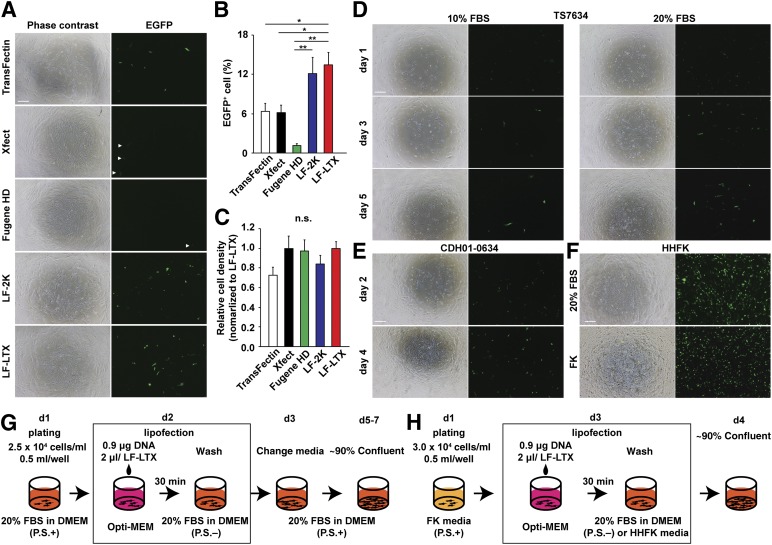Figure 1.
Optimization of single lipofection in human skin fibroblasts and hair follicle keratinocytes. (A): Phase contrast images (left) and fluorescent images (right) of IMR90 cells transfected with TransFectin, Xfect, Fugene HD, LF-2K, and LF-LTX. An episomal vector pCXLE-EGFP was used as a reporter to examine gene transduction in IMR90 cells. Arrowheads show EGFP-positive cells with Xfect and Fugene HD because of lower expression. EGFP-positive cell number (B) and relative cell density (C) after transfection at day 5 were examined. These results revealed that LF-LTX shows higher transfection efficiency and lower toxicity than did other candidates in human fibroblasts. ∗, p < .05, ∗∗, p < .01, with one-way analysis of variance (multiple comparisons). (D): LF-LTX and pCXLE-EGFP episomal vector were used for transfection in patient fibroblasts to examine whether this protocol works for patient skin fibroblasts of TS7634 in 24-well plates. After lipofection, culture media was changed to 10% or 20% FBS-containing DMEM without antibiotics. (E): An identical condition of lipofection was tested in the fibroblasts of 1 patient, CDH01-0634. DMEM containing 20% FBS was used after lipofection. (F): LF-LTX and pCXLE-EGFP episomal vector were used for transfection in HHFKs to examine whether this protocol works for keratinocytes in 20% FBS-containing DMEM (top) and FK (bottom). (G): Outline of lipofection using LF-LTX in human skin fibroblasts. (H): Outline of lipofection using LF-LTX in HHFKs. Scale bars = 250 μm. Abbreviations: ACTN2, actinin 2; d, day; DMEM, Dulbecco’s modified Eagle’s medium; EGPP, enhanced green fluorescent protein; FBS, fetal bovine serum; FK, keratinocyte-specific media; HHFK, human hair follicle keratinocyte; LF-2K, Lipofectamine 2000; LF-LTX, Lipofectamine LTX; TS7634, long QT syndrome; P.S., penicillin and streptomycin.

